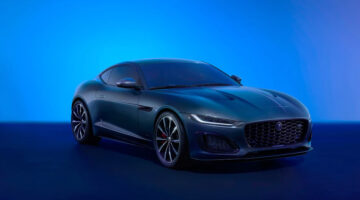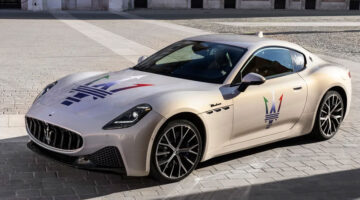Jaguar dropped the news we’d all been waiting for since the New York Auto Show. The small, nimble, terribly sexy sports car was coming back in the fray. The one thing that was missing though was any details regarding the power-train. At first we sat back and questioned why they were being a little tight lipped about the info, but it came clear pretty quick. China was just around the corner. Big market, huge potential, global Motor Show, more news.
So at the launch of the Beijing Motor Show, Jaguar decided to reveal not one but two new motors that are destined to find homes across the range. First up a supercharged V6 and second, but by no means least, a turbocharged I4.
The six pot is the big news here. Using the main structure of the Jaguar 5.0 liter V8, less two cylinders off the back of the block, the feisty six churns out a sizeable 375 horsepower and 339 lb-ft of twist. That particular version will only be available in the F-Type, while a slightly lesser version – 335 hp, 332 lb-ft – will popped into the XJ and XF.
The second engine and the one that interests us, is the 2.0 liter turbo four. It’s exactly the same engine found in the front of Range Rover Evoque, making 237 horsepower and 251 lb-ft of torque (and also connected to an eight-speed automatic).
All good news from our side and if Jaguar manage to keep the gorgeous exhaust note the V6 is clearly capable of, the world will be a better place >>>
All the press info is right under here
Introduction
As Jaguar expands its product offer in key global markets it is introducing two additional petrol units to its range to enhance customer choice; the new 3.0-litre V6 Supercharged Petrol, and the 2.0-litre I4 Turbocharged Petrol.
Adrian Hallmark, Global Brand Director, Jaguar Cars, said: “Jaguar currently has its strongest range of products for several decades. Our continued growth is dependent on two things; activating the awareness of the brand, and expanding our range to enable us to access new customers in both existing and emerging markets. The introduction of these two additional forced-induction petrol engines is integral to this ambitious plan.”
The 3.0 V6 S/C petrol engine has been developed by Jaguar powertrain experts from its existing award-winning 5.0-litre V8 – the all-alloy engine which has received plaudits from around the world in applications from long wheelbase limousines to 300km/h convertibles. The 3.0 V6 S/C shares many of the V8’s key technologies including direct injection, variable valve timing, and aluminium construction and offers comparable levels of refinement and driveability to the naturally-aspirated version of the V8 engine, but with greater specific output and efficiency courtesy of supercharging technology.
In its 340PS/450Nm guise the 3.0 V6 S/C offers the smooth, seamless performance ideally suited to a Jaguar saloon while the 380PS/460Nm version offers the visceral thrill you’d expect for the F-TYPE, the forthcoming new Jaguar sports car. In both states of tune the 3.0 V6 S/C will give performance levels matching much larger engines while remaining economy and emissions friendly.
The 2.0-litre I4 Turbocharged Petrol engine uses a range of state-of-the-art technologies for power generation that belies its size, and its introduction to XF and XJ models will see it installed in north-south orientation. It produces 240PS and 340Nm thanks to the use of three key innovations; low-inertia turbocharging, direct fuel-injection and variable timing of both the intake and exhaust camshafts.
Ron Lee, Group Chief Engineer Powertrain, Jaguar Cars, said: “Both the 3.0 V6 S/C and 2.0 I4 Ti make intelligent use of forced-induction technology to produce high-specific output in an efficient way, while delivering the compelling combination of flexibility, refinement and driver reward that are integral attributes in all Jaguar engines.”
Both engines will be mated to the eight-speed automatic gearbox introduced on specific 2012 model year Jaguars which offers a broad spread of ratios for a perfectly balanced combination of smooth-shifting, economy and driver control. The 3.0 V6 S/C will also be available with Jaguar’s Intelligent Stop-Start system.
3.0-litre V6 Supercharged Petrol
Jaguar has established itself as a leader in the field of supercharged induction technology in order to extract the highest efficiency from its powerplants. Currently, supercharging is used to greatest effect in the XKR-S which produces 550PS and 680Nm from its acclaimed 5.0-litre V8 engine.
It is this same award-winning engine architecture which forms the basis for Jaguar’s new 3.0 V6 S/C and which helps it produce higher specific outputs than even the astonishing XKR-S. The engine will be presented in two states of tune depending on its application; the 380PS/460Nm version will be used exclusively in Jaguar’s forthcoming new F-TYPE sports car while the 340PS/450Nm version will also join the powertrain line-up for the XF and XJ saloons.
The new quad-cam V6 shares its all-aluminium construction with the V8, with the lightweight die-cast block supplemented with cross-bolted main bearing caps to increase rigidity and therefore refinement. The four-valve cylinder heads are constructed of recycled aluminium.
The valves themselves are subject to control by a dual independent variable cam timing (DIVCT) system which is activated by the positive and negative torques generated by the movement of the intake and exhaust valves. This variable timing system features actuation rates of more than 150 degrees per second throughout the rev range, to optimise power, torque and economy at all engine speeds.
This responsive and uninterrupted power delivery is made possible through the use of spray-guided direct injection (SGDI) which delivers precisely measured quantities of fuel directly into the centre of the combustion chambers at pressures of up to 150bar. The fuel is delivered several times during each combustion cycle, creating a more homogenous air-fuel mixture for cleaner and more efficient combustion.
This is aided by an innovation new to this engine to maximise combustion efficiency; spark plugs which are precisely oriented both in relation to the injector and within the combustion chamber. The compression ratio is also raised from 9.5:1 in the supercharged V8 to 10.5:1, further improving fuel economy and reducing emissions.
Mounted in the ‘V’ of the engine is latest-generation Roots-type twin vortex supercharger, its use key to the 3.0 V6 S/C’s high-specific output and efficiency. More compact than the model used with the V8, a water-cooled intercooler reduces the temperature of the intake air to optimise power and efficiency. New to the 3.0 V6 S/C is that the supercharger boost control is electronically supervised by new Bosch engine management software, offering efficiency gains of up to 20 per cent.
The inherent engineering integrity of the 3.0 V6 S/C’s design meant that no alterations to the hardware or ancillaries were necessary in achieving the additional power and torque of the higher-output variant for the F-TYPE. In this higher state of tune, the 3.0 V6 S/C produces the greatest specific power output of any Jaguar engine to date; 127PS per-litre. This was achieved through recalibration of the electronic bypass of supercharger and throttle in order to increase boost without impacting emissions levels.
In creating the new 3.0 V6 S/C, Jaguar’s engineers devised an innovative system of counter-rotating front and rear balancer weights which lend it the same smoothness and refinement characteristics as its larger V8 brother.
The 3.0 V6 S/C Powertrain is completed by the Jaguar-tuned eight-speed automatic transmission from experts ZF. This transmission’s large spread of ratios allow the engine’s prodigious power to be fully exploited while optimising economy and emissions. Efficiency is also boosted by the engine’s compatibility with Jaguar’s Intelligent Stop-Start system which improves fuel consumption by up to seven per cent on the EU combined cycle. Utilising a twin solenoid starter, the system is able to restart the engine in less time than it takes for the driver’s foot to move from the brake to the accelerator, and in engine rundown ‘change of mind’ scenarios it is able to reenergise the engine via rapidly refuelling the cylinders.
In the XF the 3.0 V6 S/C will replace the naturally-aspirated version of the 5.0-litre V8 in all markets for the 2013 Model Year. In the XJ the 3.0 V6 S/C will replace the naturally-aspirated version of the 5.0-litre V8 in the majority of markets for the 2013 Model Year. Specific model-by-model economy and emissions figures will be issued on a market-by-market basis.
2.0-litre I4 240 Turbocharged Petrol
The introduction of the 2.0 I4 Ti 240 to the Jaguar range in XF and XJ saloons marks a key response to the growing demands of legislation and customer demand alike. The 2.0 I4 Ti 240’s use in the XF and XJ sees it oriented in north-south configuration and mated to the same smooth-shifting eight-speed transmission used on the 3.0 V6 S/C. Again, this transmission’s large spread of ratios maximises both performance and efficiency.
Producing 240PS at 5,500rpm (for a high specific output of 120PS per-litre) and 340Nm of torque between 1,800 and 4,000rpm, the 2.0 I4 Ti 240 offers flexible delivery, and with an ‘as-shipped’ weight of 138kg courtesy of compact dimensions and all-aluminium construction it is also the lightest Jaguar engine ever. This small mass aids dynamic agility while, of course, bringing further emissions and economy benefits.
The 2.0 I4 Ti 240 is an engine that retains all the true Jaguar qualities of muscular potential, refinement and soul-stirring character with far better efficiency than a larger capacity multi-cylinder engine that would traditionally have been required to produce similar levels of power. For example, the peak torque output of the 2.0 I4 Ti 240 exceeds that of Jaguar’s 3.2-litre naturally-aspirated V8 from just ten years ago.
Despite its small capacity, it is the 2.0 I4 Ti 240’s use of a low-inertia turbocharger that enables it to produce its high-specific power and torque outputs. The 2.0 I4 Ti 240’s turbocharger is fed via a lightweight thin-walled exhaust manifold which allows for a shorter engine warm-up period and therefore lowers emissions still further.
In order to provide the muscular usability characteristics required, chain-driven variable timing is applied to both the intake and exhaust valves to maximise the broad spread of torque, strong bottom-end performance and outstanding drivability.
Designed from the outset with the goal of enhanced efficiency, the engine features specialised coatings on the piston rings and tappets in order to reduce unwanted internal friction. This same thinking led to the adoption of very precisely controlled direct injection technology. Fuel is injected in precisely measured doses several times during each combustion cycle to ensure the most efficient possible burn with the maximum benefit in terms of power generation and the lowest fuel consumption and emissions.
Jaguar levels of smoothness and sophistication have been achieved through the use of twin balancer shafts while significant steps have been taken to ensure expected levels of refinement. Amongst these are active engine mounts, an acoustic cover and the use of high density foam for additional sound deadening.
The 2.0 I4 Ti 240’s introduction will be key to meeting customer demand in global markets which currently take the XF and XJ with the existing naturally-aspirated Jaguar 3.0-litre AJV6 engine – the 2.0 I4 Ti 240 will replace this unit.
Technical specifications
3.0-litre V6 340 Supercharged Petrol
Engine type: V6, petrol, supercharged
Capacity (cc): 2,995
Bore/stroke (mm): 84.5/89
Peak power (PS@rpm): 340@6,500
Peak torque (Nm/lb ft@rpm): 450/332@1,800-4,000rpm
0-60mph (secs): 5.7 (in XF and XJ)*
Top speed (mph): 155mph (limited, in XF and XJ)*
3.0-litre V6 380 Supercharged Petrol (F-TYPE only)
Engine type: V6, petrol, supercharged
Capacity (cc): 2,995
Bore/stroke (mm): 84.5/89
Peak power (PS@rpm): 380@6,500
Peak torque (Nm/lb ft@rpm): 460/339@1,800-4,000rpm
0-60mph (secs): figures not yet available
Top speed (mph): figures not yet available
2.0 I4 240 Turbocharged Petrol
Engine type: four-cylinder, in-line petrol, turbocharged
Capacity (cc): 1999
Bore/stroke (mm): 87.5/83.1
Peak power (PS@rpm): 240@5500
Peak torque (Nm/lb ft@rpm): 340/251@1800-4,000
0-60mph (secs): 7.5 (in XF and XJ)*
Top speed (mph): 150 (in XF and XJ)*
*Manufacturer’s estimates. All figures correct at time of going to press.



